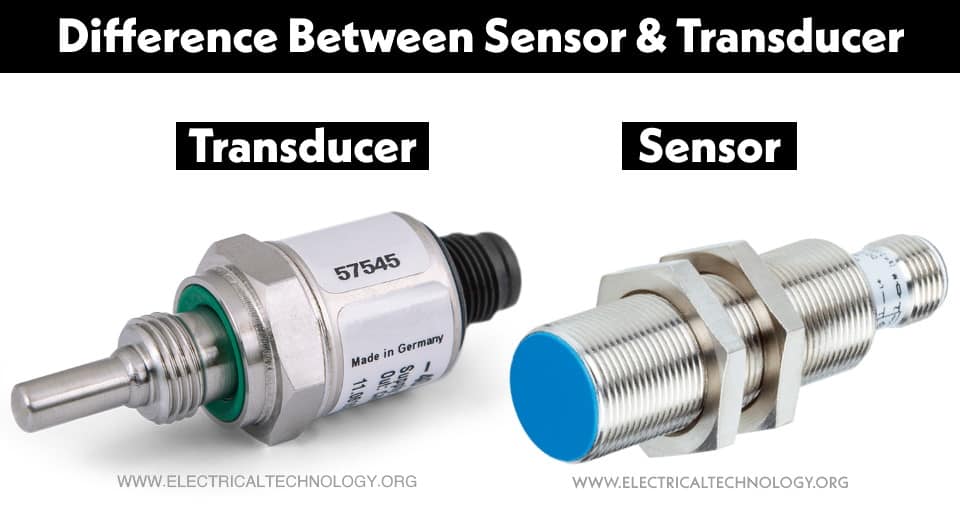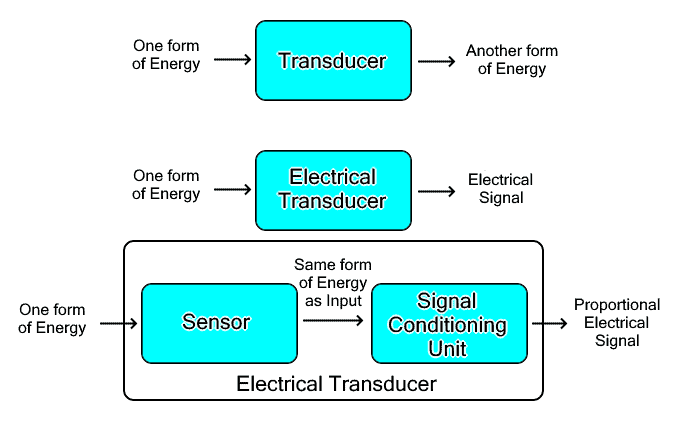Main Difference between Sensor and Transducer
What is the Difference between Sensors and Transducers?
The term sensor and transducer is used interchangeably in electronics engineering. They are extensively used in electronic applications and other smart gadgets and devices. They are mostly confused with each other.
Sensors and transducers are used to convert the physical quantities and energy from its surrounding into an easily readable signal or electrical signal. They are used to detect and measure various physical quantities in automation and instrumentation.
- Related Post: Difference between Sensor and Actuator
What is a Sensor?
A sensor is a physical device that detects or senses changes in any physical quantity or energy. It reacts to stimuli of the surrounding environment and provides a non-electrical signal. A sensor can sense various kinds of electrical quantities such as heat, light, pressure, humidity, motion etc.
The output signal of a sensor is not necessarily in a readable form. it is processed further such as amplify, attenuate or convert using an electronic circuit into a readable signal.
An example of a sensor is the mercury in a thermometer. Mercury is a liquid metal that expands with an increase in temperature. It can sense the temperature and any changes in it. However, it is not readable unless it is placed in a specific scale. Similarly, a thermistor’s resistance varies with changes in temperature.
Other examples of a sensor are a potentiometer whose resistance varies with the position of its knob. The resistance is not readable unless voltage is applied to it. The change in resistance is visible in the form of a change in the electrical signal.
Main Features of Sensor
- It senses or detects changes in any physical quantity.
- A sensor is a component itself and it does not have signal conditioning unit.
- Its output may or may not be electrical in nature.
- Its output signal needs a scale or processing circuit to make it readable.
Related Post: What is a Sensor? Different Types of Sensors with Applications
What is a Transducer?
A transducer is a physical device that converts one form of energy into another. Whereas an electrical transducer converts other forms of energy into an electrical signal. The process of energy conversion is called transduction.
A transducer is made of two parts; a sensor and a signal conditioning unit. The sensor detects the change in the physical environment and generates a non-electrical signal. The signal conditioning unit converts the signal into electrical form and also amplifies, attenuate or process it into a readable electrical signal.
An example of a transducer is a pressure transducer that converts the pressure applied or stress into an electrical signal. It is made of two oppositely charged plates where one of it is fixed and the other is movable. When pressure is applied on the moving plate, the capacitance in-between varies. The change in capacitance varies the applied voltage. Thus the pressure is converted into an electrical signal.
Main Feature of Transducer
- It converts one form of energy into another.
- It is made of a sensor and a signal conditioning unit.
- It can convert non-electrical into electrical energy and vice versa.
- Its output can be directly interfaced with another system.
- A transducer has a complex signal conditioning circuit.
Related Post: What is a Transducer? Types of Transducers and Applications
Key Differences between Sensor and Transducer
| Sensor | Transducer |
| A sensor is a device that detects a change in a physical environment. | A transducer is a device that converts one form of energy into another. |
| A sensor is not necessarily a transducer. | Every transducer includes a sensor as a component. |
| A sensor itself is a component. | Transducer is made of a sensor and a signal conditioning circuit. |
| Sensor converts physical quantities or energy into non-electrical signal. | A transducer converts physical quantity or energy into an electrical signal. |
| A sensor requires an additional circuit to process its output signal into a readable form. | A transducer does not require any processing circuit. Its output is directly interfaced with a device or display. |
| A sensor’s output is analog in nature. | A transducer can generate analog as well as a digital output. |
| A sensor’s output cannot be directly applied to any other system. | A transducer’s output can be directly connected to another system. |
| A sensor does not require external power to operate. | A passive transducer requires an external power source to operate. |
| A sensor cannot be bidirectional i.e. it only converts physical quantities into readable form. | A transducer is bidirectional. It can also convert electrical signal into physical quantities called an inverse transducer. |
| A sensor is a simple device. | A transducer has a complicated electrical circuit used for energy conversion. |
| Examples of sensors are thermometer, pressure sensor, ultrasonic sensor, light sensor, etc. | Examples of transducers are thermistor, potentiometer, piezoelectric transducer, Hall Effect transducer, etc. |
Related Posts:
- LVDT: Linear Variable Differential Transformer and Inductive Sensors
- Capacitive Sensor and Transducer and Its Applications
Comparison between Sensor and Transducer
- A sensor senses or detects physical quantities in its surrounding while a transducer converts one form of energy into another form.
- A sensor is a component itself while a transducer contains a sensor as a component in addition with signal conditioning unit.
- A sensor is not necessarily a transducer while a transducer must include a sensor.
- The output of a sensor may or may not be an electrical signal while the output of a transducer is an electrical signal.
- A sensor generates an analog output signal in real-time while a transducer can generate analog as well as a digital electrical signal.
- A sensor cannot be directly interfaced with other systems while a transducer can be directly connected.
Conclusion: Sensor and transducer are both used interchangeably, however; sensor refers to physical devices that only sense or detect any physical quantity or changes in it. While a transducer refers to those devices that convert one form of energy into another. Transducer is a broad term while a sensor is a sub-component of a transducer. Therefore we can say that all sensors are transducers but not the other way around.
Related Posts:
- Difference Between Thermistor and Thermocouple
- What is Piezoelectric Sensor? Construction, Working and Applications
- Types of Resistive Sensors and Transducer, Potentiometer and Strain Gauge
- PIR – Infrared Motion Detector Circuit Diagram, Working and Applications
- Automatic Plant Watering and Irrigation System – Circuit, Code and Project Report
- Automated Fingerprint Identification System and How it Works?
- Infrared Motion Detector Circuit – Diagram, Working and Applications
- Rain Alarm Sensor– Snow, Water and Rain Detector Project
- Simple Touch Sensitive Switch Circuit using 555 Timer and BC547 Transistor
- Automatic Bathroom Light Switch Circuit Diagram and Operation
- Internet of Things (IoT) and Its Applications in Electrical Power Industry
- What is a Thermistor? Types of Thermistors and Applications









